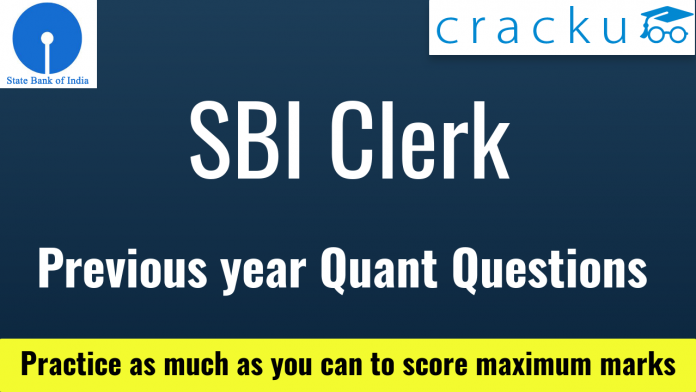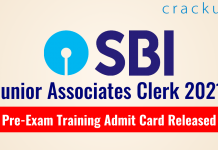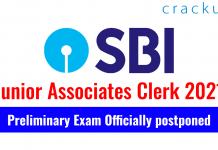SBI Clerk Quant Previous year 2018 asked Questions With Video Explanations PDF
For Previous year Quant questions of SBI clerk 2018 prelims exam download PDF. Go through the video of Quant questions explanations.
Download Expected Reasoning Questions for SBI Clerk PDF
790+ Mocks – Just Rs. 194. Use coupon: SBIDREAM70
SBI Clerk Topic-Wise Important Questions (Download PDF)
Watch the video here (If not loaded below)
Instructions
What should come in place of the question mark (?) in the following number series?
Question 1: 17, 19, 23, 29, 37, ?
a) 46
b) 49
c) 47
d) 48
e) 45
Question 2: 900, 899, 891, 864, 800, ?
a) 695
b) 685
c) 665
d) 675
e) 655
Question 3: 4, 32, 224, 1344, 6720, ?
a) 26885
b) 26880
c) 26882
d) 26888
e) 26883
Question 4: 56, 54, 58, 50, 66, ?
a) 34
b) 98
c) 38
d) 94
e) 44
Question 5: 655, 637, 622, 610, 601, ?
a) 598
b) 593
c) 595
d) 597
e) 594
Download SBI Clerk Previous Papers PDF
Take a free mock test for SBI Clerk
Download SBI Clerk Quant Expected Questions PDF
Instructions
approximate value will sonar place of the question mark (1 in ilk. following questions ? (you are not required to calculate the exact value.).
Question 6: 10303.88 $\div$ 55.94 + 62.95 = ?
a) 247
b) 250
c) 260
d) 220
e) None of these
Question 7: $\sqrt{\frac{12321}{36.07}} = ?$
a) 20
b) 18.5
c) 17
d) 17.5
e) None of these
Question 8: 19.03 $\times$ 16.98 $\times$ 13.01 = ?
a) 4000
b) 4100
c) 4200
d) 4250
e) None of these
Question 9: 117% of 459.88 – 162% of 143.02 = ?
a) 290
b) 280
c) 300
d) 306
e) None of these
Question 10: 3/5 $\times$ 4/9 $\times$ 5894.92=?
a) 1527
b) 1572
c) 1752
d) 1725
e) None of these
Instructions
In these questions, two equations numbered I and II are given. You have to solve both the equations and mark the appropriate answer. Give answer :
a:If x < y
b: If x > y
c: If x ≤ y
d: If x ≥ y
e: If relationship between x and y cannot be determined ,
Question 11: I. $15x^{2} + 26x + 8 = 0$
II. $25y^{2} + 15y + 2 = 0$
a) If x < y
b) If x > y
c) If x ≤ y
d) If x ≥ y
e) If relationship between x and y cannot be determined
Question 12: I. $6x^{2} – 19x + 15 = 0$
II. $5y^{2} – 22y + 24 = 0$
a) If x < y
b) If x > y
c) If x ≤ y
d) If x ≥ y
e) If relationship between x and y cannot be determined
Question 13: I. $4x^{2} – 12x + 5 = 0$
II. $4y^{2} – 8y + 3 = 0$
a) If x < y
b) If x > y
c) If x ≤ y
d) If x ≥ y
e) If relationship between x and y cannot be determined
Question 14: I. $10x^{2} + 21x + 8 = 0$
II. $5y^{2} + 19y + 18 = 0$
a) If x < y
b) If x > y
c) If x ≤ y
d) If x ≥ y
e) If relationship between x and y cannot be determined
Question 15: I. $6x^{2} – 5x + 1 = 0$
II. $12y^{2} – 23y + 10 = 0$
a) If x < y
b) If x > y
c) If x ≤ y
d) If x ≥ y
e) If relationship between x and y cannot be determined
Banking Study Material – 15000 Questions
Instructions
In the given questions, two quantities are given, one as Quantity I and another as Quantity II. You have to determine relationship between two quantities and choose the appropriate option.
a: If quantity I ≥ quantity II
b: If quantity I > quantity II
c: If quantity I < quantity II
d: If quantity I = quantity II or the relationship cannot be established from the information that is given
e: If quantity quantity II
Question 16: Arun and Bhadra are brothers. In how many years from now will Bhadra’s age be 50 years ? •
I. The ratio of the current ages of Arun and Bhadra is 5 : 7 respectively.
II. Bhadra was born 10 years before Arun.
III. 5 years hence, Arun’s age would be three-fourth of Bhadra’s age at that time.
a) Any two of the three
b) Only II and either I or III
c) All I, II and III
d) Only II and III
e) Only I and III
Question 17: A right-angled triangle is inscribed in a given circle. What is the area of the given circle (in cm2) ?
I. The base and height of the triangle (in cm) are both the roots of the equation $x^{2}-23x+120=0$
II. The sum of the base and height of the triangle is 23 cm.
III. The height of the right-angled triangle is greater than the base of the same.
a) III and either omly I or only II
b) ALL I,II and III
c) Only II and III
d) Only I
e) Either I or II
Answers & Solutions:
1) Answer (C)
Let the missing number be x
Here the pattern is
19-17 = 2
23-19 = 4
29-23 = 6
37-29 = 8
As we can see that the difference is geeting increased by 2 every time so ,
x-37 =10,it implies x= 47
2) Answer (D)
Let the missing number be x
900-899 = (1)^2
899-891 = 8 = (2)^3
891-864 = 27 = (3)^3
864-800 = 64 = (4)^3
as we can see the pattern between differences of consecutive numbers is of type (n)^3
so x-800 = (5)^3,this implies that x= 675
3) Answer (B)
Let the missing number be x
32÷4 = 8
224÷32 = 7
1344÷224 = 6
6720÷1344 = 5
As we can see that the division of consecutive numbers is forming a pattern of decreasing numbers by 1, so
x÷6720 = 4, it implies x is 26880
25 SBI Clerk Prelims Mocks – Rs. 149
Take a free mock test for SBI Clerk
4) Answer (A)
Let the missing number be x
Here , a pattern is getting formed between consecutive numbers.
54−56 =$(-2)^1$
58−54= $(-2)^2$
50−58= $(-2)^3$
66−50= $(-2)^4$
As we can see that the difference is of the form $(-2)^{n}$
so for missing number x,
x−66= $(-2)^{5}$
This implies that x is 34
5) Answer (C)
Let the missing number be x.
The difference between every two consecutive numbers is forming a pattern.
655-637 = 18
637-622 = 15
622-610 = 12
610-601 = 9
As the difference is getting reduced by 3 every time . So 601-x = 6 which implies that the missing number ,x =595
6) Answer (A)
10303.88$\div$55.94 + 62.95.
~10304$\div$56+63.
=184+63.
=247.
Hence, Option A is correct.
7) Answer (B)
$\sqrt{\frac{12321}{36.07}}$.
~$\sqrt{\frac{12321}{36}}$.
We know that,
$111^{2}=12321, 6^{2}=36$.
~$\sqrt{\frac{12321}{36}}=\frac{111}{6}$.
=$18.5$.
Hence, Option B is correct.
8) Answer (C)
19.03 $\times$ 16.98 $\times$ 13.01.
~19 $\times$ 17 $\times$ 13.
=4199.
~4200.
Hence, Option C is correct.
9) Answer (D)
117% of 459.88 – 162% of 143.02.
~117% of 460-162% of 143.
=$\frac{117\times460}{100}-\frac{162\times143}{100}$.
=$\frac{53820}{100}-\frac{23166}{100}$.
=$538.20-231.66$.
~$306$.
Hence, Option D is correct.
10) Answer (B)
3/5 $\times$ 4/9 $\times$ 5894.92.
~3/5 $\times$ 4/9 $\times$ 5895.
=$3\times4\times131$.
=$1572$.
Hence, Option B is correct.
11) Answer (C)
I. $15x^{2} + 26x + 8 = 0$
=> $15x^2 + 6x + 20x + 8 = 0$
=> $(3x + 4) (5x + 2) = 0$
=> $x = \frac{-4}{3} , \frac{-2}{5}$
II. $25y^{2} + 15y + 2 = 0$
=> $25y^2 + 5y + 10y + 2 = 0$
=> $(5y + 2) (5y + 1) = 0$
=> $y = \frac{-2}{5} , \frac{-1}{5}$
$\therefore x \leq y$
12) Answer (A)
I. $6x^{2} – 19x + 15 = 0$
=> $6x^2 – 9x – 10x + 15 = 0$
=> $(3x – 5) (2x – 3) = 0$
=> $x = \frac{5}{3} , \frac{3}{2}$
II. $5y^{2} – 22y + 24 = 0$
=> $5y^2 – 10y – 12y + 24 = 0$
=> $(5y – 12) (y + 2) = 0$
=> $y = \frac{12}{5} , 2$
$\therefore y > x$
13) Answer (E)
I. $4x^{2} – 12x + 5 = 0$
=> $4x^2 – 2x – 10x + 5 = 0$
=> $(2x – 5) (2x – 1) = 0$
=> $x = \frac{5}{2} , \frac{1}{2}$
II. $4y^{2} – 8y + 3 = 0$
=> $4y^2 – 2y – 6y + 3 = 0$
=> $(2y – 3) (2y – 1) = 0$
=> $y = \frac{3}{2} , \frac{1}{2}$
$\therefore$ No relation can be established.
14) Answer (B)
I. $10x^{2} + 21x + 8 = 0$
=> $10x^2 + 5x + 16x + 8 = 0$
=> $(5x + 8) (2x + 1) = 0$
=> $x = \frac{-8}{5} , \frac{-1}{2}$
II. $5y^{2} + 19y + 18 = 0$
=> $5y^2 + 10y + 9y + 18 = 0$
=> $(5y + 9) (y + 2) = 0$
=> $y = \frac{-9}{5} , -2$
$\therefore x > y$
15) Answer (A)
I. $6x^{2} – 5x + 1 = 0$
=> $6x^2 – 2x – 3x + 1 = 0$
=> $2x (3x – 1) – 1(3x – 1) = 0$
=> $(2x – 1) (3x – 1) = 0$
=> $x = \frac{1}{2} , \frac{1}{3}$
II. $12y^{2} – 23y + 10 = 0$
=> $12y^2 – 8y – 15y + 10 = 0$
=> $4y (3y – 2) – 3 (3y – 2) = 0$
=> $(4y – 3) (3y – 2) = 0$
=> $y = \frac{3}{4} , \frac{2}{3}$
$\therefore y > x$
16) Answer (A)
I & II : Let Arun’s age = $x$ years
=> Bhadra’s age = $x + 10$ years
$\therefore \frac{x}{x + 10} = \frac{5}{7}$
=> $7x = 5x + 50$
=> $7x – 5x = 2x = 50$
=> $x = \frac{50}{2} = 25$
=> Bhadra’s age = $25 + 10 = 35$ years
Thus, I & II are sufficient.
II & III : Let Arun’s age = $x$ years
=> Bhadra’s age = $x + 10$ years
$\therefore \frac{x + 5}{x + 15} = \frac{3}{4}$
=> $4x + 20 = 3x + 45$
=> $4x – 3x = 45 – 20$
=> $x = 25$
=> Bhadra’s age = $25 + 10 = 35$ years
Thus, II & III are sufficient.
I & III : Let Arun’s age = $5x$ years
=> Bhadra’s age = $7x$ years
$\therefore \frac{5x + 5}{7x + 5} = \frac{3}{4}$
=> $20x + 20 = 21x + 15$
=> $21x – 20x = 20 – 15$
=> $x = 5$
=> Bhadra’s age = $7 \times 5 = 35$ years
Thus, I & III are sufficient.
$\therefore$ Any two of the three statements are sufficient.
17) Answer (D)
I : $x^2 – 23x + 120 = 0$
=> $x^2 – 8x – 15x + 120 = 0$
=> $x (x – 8) – 15 (x – 8) = 0$
=> $(x – 8) (x – 15) = 0$
=> $x = 8 , 15$
Thus, base = 8 cm and height = 15 cm (or vice versa)
=> Hypotenuse of right angled triangle = $\sqrt{(8)^2 + (15)^2}$
= $\sqrt{64 + 225} = \sqrt{289} = 17 cm$
Since, triangle is inscribed in circle, => Radius of circle = half of hypotenuse
=> $r = \frac{17}{2} = 8.5$ cm
$\therefore$ Area of circle = $\pi r^2$
= $\frac{22}{7} \times 8.5 \times 8.5 \approx 227 cm^2$
Thus, I alone is sufficient.
Clearly, we cannot find base and height from statements II or III. Thus, they are insufficient.





